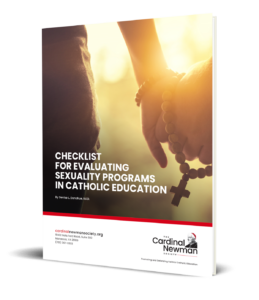Checklist for Evaluating Sexuality Programs in Catholic Education
Checklist for Evaluating Sexuality Programs in Catholic Education
To assist parents in the delicate area of instructing children with regard to affectivity and sexuality, some Catholic schools and other Catholic education programs may choose to include human sexuality programs at the middle school or high school level. The Church has provided specific parameters for such instruction.
The checklist below may be used in conjunction with The Cardinal Newman Society’s Policy Standards for Sexuality Programs in Catholic Education which provides historical and theological background, Church expectations, and principles and standards for Catholic school human sexuality programs.
Checklist for Evaluating Sexuality Programs
Determine whether the program and materials:
are delivered under the attentive guidance of a student’s parents with their knowledge, collaboration, and approval. (Consider having parental consent forms on file.)
Yes / No
are grounded in a clear and convincing Christian anthropology that respects man’s God-given nature as a body/soul unity that cannot be manipulated at will.
Yes / No
fully reflect, without ambiguity or reservation, the moral precepts of the Church regarding human sexuality, as presented in the Catechism of the Catholic Church.
Yes / No
are presented from a Catholic worldview of the sacramentality of marriage, as a lifelong union between a man and a woman.
Yes / No
present the beauty and dignity of the marital act as proper only within the confines of marriage for the procreation of children and bonding of the spouses.
Yes / No
address and negate practices and behaviors which are contrary to Christian morality, including sexual activity outside of marriage (including same-sex activity), contraception, abortion, transgenderism, masturbation, sex trafficking, and pornography.
Yes / No
specifically and clearly promote the virtue of chastity.
Yes / No
promote self-control, modesty, temperance, fortitude, and respect for self and others.
Yes / No
present all information at an age-appropriate developmental level carefully protecting a child’s natural latency period and prudently introducing relevant material during adolescence to guide a child through development and change.
Yes / No
when possible, separate students by biological sex.
Yes / No
refrain from sexually explicit materials, images, or language that might create emotional disorientation in students or unhealthy curiosity which may lead to sin.
Yes / No
make a distinct effort to counter harmful or false information students receive from mass media, social networking, and peer groups which may be beyond their comprehension, or which may lead them to premature assumptions about their own possibly misguided sexuality.
Yes / No
protect student modesty and purity by avoiding flippant, cynical, ambiguous, or indecent approaches to the topic.
Yes / No
utilize various instructional approaches that retain the modesty and dignity of the person, such as role-play, discussions, and stories that invite a student to make a personal commitment to chastity.
Yes / No
is delivered by well-trained and well-formed staff in the proper context.
Yes / No
Human sexuality programs should be rejected if they explicitly violate any of these areas. In some cases, if a program simply omits an area without contradicting it, the program might still be considered but should be richly supplemented in that area.


